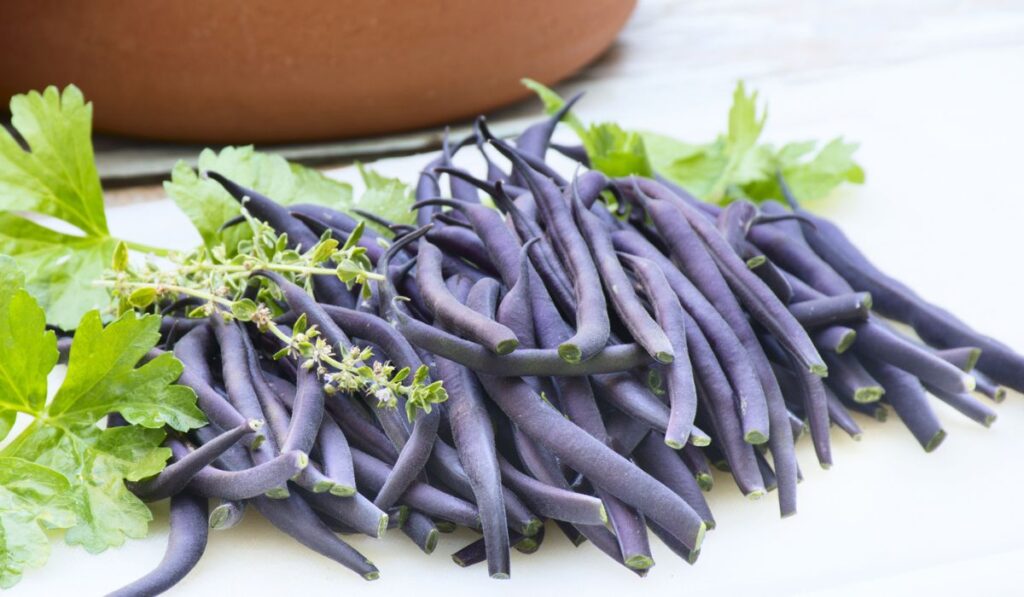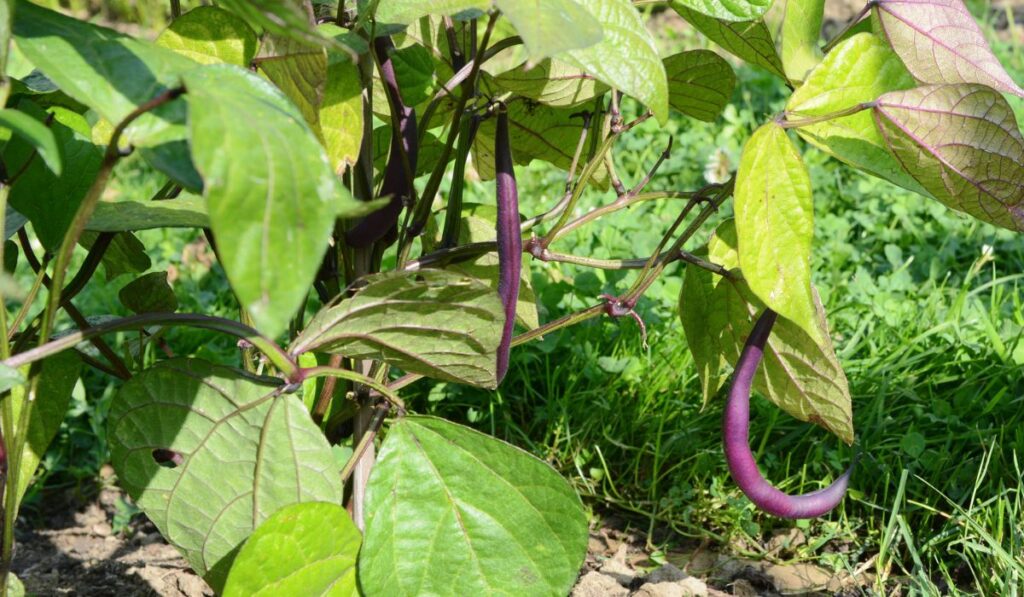Purple hull peas have a solid cultural status, with Southern folks even holding festivals to honor this nutritious legume. However, unlike common peas that do well in colder weather, purple hull peas have a love of warm weather, more like beans. So, when and how do you plant purple hull peas?
The best time to plant purple hull peas is in late spring when the danger of frost has passed. You can also plant them mid-summer and make successive sowings every two weeks. Plant the peas 1 inch deep in raised rows and leave 24 inches between the rows. Water them and install stakes for support.
Let’s take a closer look at how to plant and care for purple hull peas so that you can successfully grow this delicious legume right at home.
When Should You Plant Purple Hull Peas?

You should plant purple hull peas anytime from late spring to mid-summer. If you’re planting in the spring, it should be 2 to 3 weeks after the last average frost date. Remember, purple hull peas are a warm season annual that can’t withstand frost, so proper timing is essential for a good crop yield.
Sow the first seeds when the air temperature is reliably above 70℉ and the soil is warm enough, at around 60℉. If you’re looking for a continued harvest, sow the purple hull peas every two weeks during this period.
From then on, you won’t have to deal with tedious care routines, as this Southern pea variety is fairly easy to grow.
What Are the Varieties of Purple Hull Peas?
Over the years, plant breeders have developed quite a number of cultivars of the purple hull pea. The new cultivars are more tolerant to drought and give a better annual yield than the original species, which was native to Africa.
These are the top varieties of purple hull peas you can grow in your garden:
- Magnolia is a disease-resistant cultivar with medium-sized pods that turn yellow when ripe. It may not be as productive as other varieties like the Mississippi Silver.
- Mississippi purple is a favorite cultivar among farmers because its purple pods settle at the top of the plant when mature, making it easier to harvest the beans. Other than that, it’s got good drought resistance. You can expect an excellent yield from each plant.
- Mississippi silver is a high-yielding variety with a strong resistance to pests and diseases. It gets its name from the pods, which usually have a silver color with reddish streaks when mature. Still, the beans inside them maintain their creamy yellow shade and the famous purple eyes.
- Pinkeye purple hull (on Amazon) is a variety that’s similar to the original purple hull peas in every respect, except that the beans have purple eyes. You can even expect the same growth rate and yield as the original purple hull variety.
Before you choose your preferred variety of purple hull peas, it’s best to confirm that it grows well in your region. Most cultivars we’ve discussed here thrive in Southern parts of the country, where the summer temperatures are sufficiently high, and there’s plenty of sunlight.
How to Plant Purple Hull Peas
Like most legumes, starting purple hull peas from seeds is the easiest and most efficient way to grow them. However, you must ensure your seeds are from a good source and aren’t old, which could lead to dormancy.
For example, you shouldn’t use the seeds you get from the dry foods section of your local grocery store as they’re probably too old and won’t germinate.
Here’s a breakdown of the simple steps for planting purple hull peas:
- Till 6 to 8 inches of the topsoil and work in a 3-inch layer of aged farmyard manure or compost.
- Dig in 6-inch trenches and space them 24 inches apart. Create raised rows by piling the soil from the trenches onto the ground lying before each trench. If you intend to sow successively every two weeks, create at least twice as many rows for continued summer harvesting. You could also create raised beds rather than trenches, so your purple hull peas prosper in warmer soil.
- Soak the seeds overnight before planting to break seed dormancy.
- Directly sow the seeds to a depth of 1 inch and space them 2 to 3 inches within each row. Cover the seeds lightly with soil and water them, so the soil becomes evenly moist, not wet. Leave 24 inches between successive rows.
- Cover the area around the peas with mulch to conserve soil moisture and suppress weed growth, but leave the seeded rows uncovered.
- After the seeds germinate, you’ll need to wait for the seedlings to grow 3 inches tall before thinning them out.
- Wait for two weeks before you make successive sowings in raised, staked rows. It’s the one sure way you’ll make continuous harvests.
- Continue watering the soil around the peas throughout their growing season to keep it evenly moist.
Note: While you can grow purple hull peas in containers, it may not be practically sensible due to the volume of plants you’ll need to raise for a good crop.
How to Care for Purple Hull Peas
Purple hull peas require moderate care to thrive and give an appreciable yield. Here’s how to care for them until maturity:
- Thin the seedlings to 4 inches apart when they’re about 3 inches tall. Select the hardiest looking seedlings to continue growing, but cut the remaining ones at the base. Mulch around the remaining seedlings to keep the soil moist and suppress weeds.
- Purple hull peas are a bush-type legume that needs reliable support structures like stakes and teepee trellises, so be sure to support the vines. Set up trellis wire nets (on Amazon) or install stakes 4 inches apart into the raised rows. These not only support the vines but also keep the seed pods off the ground, where they could get muddy and begin to rot.
Purple hull peas don’t need any other complex maintenance measures besides these basic care routines. Moreover, they fix their own nitrogen in the soil, meaning you won’t need to fertilize them after the initial organic matter you added while sowing.
Tips for Growing Your Purple Hull Peas

Depending on the cultivar you’ve grown, purple hull peas will become ripe and ready to harvest as the summer draws to an end or even in early fall. Until then, here are some additional tips for growing them:
- Water the plants with a low nitrogen liquid fertilizer or compost tea halfway through their growing season. Since purple hull peas naturally fix nitrogen in the soil, they don’t need extra nitrogen as it would only make them too leafy rather than producing seed pods.
- If your garden already has a couple of raised beds, you might want to devote one or two of them to purple hulls in addition to successive sowing.
- While purple hull peas show twining tendencies, they’re not really pole legumes. That’s why they can use some additional support, and you should secure them to their stakes with garden twine.
- Other support structures for purple hull peas include bamboo tepees, wire cages, and lattice fencing.
